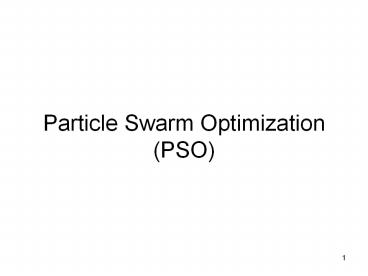Particle Swarm Optimization (PSO) - PowerPoint PPT Presentation
Title:
Particle Swarm Optimization (PSO)
Description:
Particle Swarm Optimization (PSO) Inspired by simulation social behavior Related to bird flocking, fish schooling and swarming theory - steer toward the center ... – PowerPoint PPT presentation
Number of Views:2028
Avg rating:3.0/5.0
Title: Particle Swarm Optimization (PSO)
1
Particle Swarm Optimization(PSO)
2
Origins and Inspiration from Natural Systems
Developed by Jim Kennedy, Bureau of Labor
Statistics, U.S. Department of Labor and Russ
Eberhart, Purdue University at 1995 A
concept for optimizing nonlinear functions
using particle swarm methodology
3
- Inspired by simulation social behavior
- Related to bird flocking, fish schooling
- and swarming theory
- - steer toward the center
- - match neighbors velocity
- - avoid collisions
4
- PSO algorithm is not only a tool for
- optimization, but also a tool for representing
- sociocognition of human and artificial
- agents, based on principles of social
- psychology.
- A PSO system combines local search
- methods with global search methods,
- attempting to balance exploration and
- exploitation.
5
Population-based search procedure in which
individuals called particles change their
position (state) with time.
6
- Particles fly around in a multidimensional
- search space. During flight, each particle
- adjusts its position according to its own
- experience, and according to the
- experience of a neighboring particle,
- making use of the best position encountered
- by itself and its neighbor.
7
1. Initialize population in hyperspace2.
Evaluate fitness of individual particles3.
Modify velocities based on previous best and
global (or neighborhood) best positions4.
Terminate on some condition or return to step
2
Particle Swarm Optimization(PSO) Process
8
Particle Swarm Optimization(PSO) Algorithm
Initialize location and velocity of each
particle Repeat For each particle evaluate
objective function for each particle For each
particle update best solution update best
global solution For each particle update the
velocity compute the new locations of the
articles Until finished()
9
)
10
(No Transcript)
11
(No Transcript)
12
(No Transcript)
13
(No Transcript)
14
(No Transcript)
15
Inertia Weight
- Large inertia weight facilitates global
- exploration, small on facilitates local
- exploration
- w must be selected carefully and/or
- decreased over the run
- Inertia weight seems to have attributes of
- temperature in simulated annealing
16
Vmax
- An important parameter in PSO typically the
- only one adjusted
- Clamps particles velocities on each dimension
- Determines fineness with which regions are
- searched
- if too high, can fly past optimal solutions
- if too low, can get stuck in local minima
17
PSO has a memory ?not what that best
solution was, but where that best solution
was Quality population responds to quality
factors pbest and gbest Diverse response
responses allocated between pbest band gbest
Stability population changes state only when
gbest changes Adaptability population does
change state when gbest changes
18
- There is no selection in PSO
- ? all particles survive for the length of the run
- ? PSO is the only EA that does not remove
- candidate population members
- In PSO, topology is constant a neighbor is
- a neighbor
- Population size Jim 10-20, Russ 30-40
19
- Simple in concept
- Easy to implement
- Computationally efficient
- Application to combinatorial problems?
- ? Binary PSO
20
Books and Websites
- Swarm Intelligence by Kennedy, Eberhart, and
- Shi, Morgan Kaufmann division of Academic
Press, - 2001.
- http//www.engr.iupui.edu/eberhart/web/PSObook.
html - http//www.particleswarm.net/
- http//web.ics.purdue.edu/hux/PSO.shtml
- http//www.cis.syr.edu/mohan/pso/
- http//clerc.maurice.free.fr/pso/
- http//www.engr.iupui.edu/7Eeberhart/
- http//www.particleswarm.net/JK/
21
(No Transcript)































